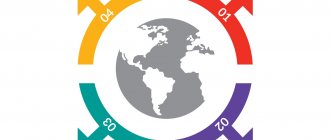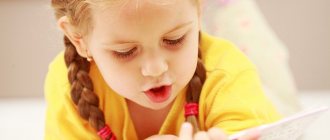When an employee first starts a job, he or she is likely most interested in responsibilities, hours, security, and salary. However, over time, any employee who has sufficient potential will want to grow and develop. The task of a good employer is to provide for the occurrence of this moment when the employee himself may not yet realize that he can be more productive. An employee's motivation and interest in work does not always correlate with a salary increase. A good employer just needs to know what an IPR is - an individual development plan for each employee.
What is IPR
An employee’s IPR is compiled individually for each person, taking into account his characteristics, position, abilities and aspirations. Such a plan should include actions that can increase the effectiveness, efficiency and determination of each individual employee.
The main goal of the IPR is maximum satisfaction of the needs of both the employee and the company for which he works. This plan may include steps that involve career growth, advanced training, work on any special projects, etc.
Features of training according to an individual curriculum
Education according to an individual plan is one of the possible options for studying at school. Training in an individual curriculum (hereinafter referred to as IEP) is enshrined in legislation in the field of education. For whom IEP training is suitable, how such training should be organized, we will consider based on the existing regulatory framework. Parents should know what such training means and what its features are if it is offered for a child.
To begin with, it should be determined that an individual curriculum is a curriculum that ensures the development of an educational program based on the individualization of its content, taking into account the characteristics and educational needs of a particular student (Clause 23, Article 2 of Federal Law No. 273-FZ of December 29, 2012 “On Education in the Russian Federation" (hereinafter referred to as the Law). An individual curriculum is developed and implemented in accordance with the Federal State Educational Standard within the framework of the educational program being mastered. The procedure for implementing training according to the IEP is determined by the school independently in accordance with the educational organization.
In addition to the provisions of the Law, provisions on IUP can be found in the following regulations:
- Order of the Ministry of Education and Science of Russia dated October 6, 2009 No. 373 “On approval of the Federal State Educational Standard for Primary General Education.”
- Order of the Ministry of Education and Science of Russia dated December 17, 2010 No. 1897 “On approval of the Federal State Educational Standard of Basic General Education.”
- Order of the Ministry of Education and Science of Russia dated May 17, 2012 No. 413 “On approval of the Federal State Educational Standard of Secondary General Education.”
- Resolution of the Chief Sanitary Doctor of the Russian Federation dated December 29, 2010 No. 189 “On approval of SanPiN 2.4.2.2821–10 “Sanitary and epidemiological requirements for the conditions and organization of training in educational institutions.”
- Resolution of the Chief State Sanitary Doctor of the Russian Federation dated July 10, 2015 No. 26 “On approval of SanPiN 2.4.2.3286–15 “Sanitary and epidemiological requirements for the conditions and organization of training and education in organizations carrying out educational activities according to adapted basic educational programs for students with disabilities health."
For which categories of students is an individual curriculum developed?
Federal Law No. 273-FZ of December 29, 2012 “On Education in the Russian Federation” (Article 34) grants students the right to study according to an individual curriculum, including accelerated learning, within the limits of the educational program being mastered in the manner established by local regulations .
Most often, the following categories of students switch to an individual curriculum:
- Gifted and highly motivated students, children with high success in mastering the educational program.
- Students with disabilities (Article 42 of the Law).
Students with disabilities should have PMPK recommendations in order to determine the necessary forms and methods of training. The standard individual curriculum for a child with disabilities must be completed in accordance with the requirements of the educational institution. The standard period for mastering the educational program of primary general education for children with disabilities can be increased taking into account the characteristics of the psychophysical development and individual capabilities of children (in accordance with the recommendations of the psychological, medical and pedagogical commission).
- Students who have not eliminated academic debt (Article 58 of the Law).
Usually these are children with persistent maladaptation and inability to master educational programs in a mass school setting. Training according to an individual curriculum must ensure the achievement of indicators that allow the student to be admitted to passing the State Examination. In relation to students with academic debt, this is a curriculum that contains compensatory measures in those subjects for which this debt has not been eliminated. Transfer to study according to an individual curriculum for students who have not eliminated their academic debt within the established time frame from the moment of its formation is carried out upon the application of the parents (legal representatives) of the student. The application indicates the period for which the student is provided with an individual curriculum, and may also contain the wishes of the student or his parents to individualize the content of the educational program.
“Students in an educational organization in educational programs of primary general, basic general and secondary general education, who have not eliminated academic debt from the moment of its formation within the established time frame, at the discretion of their parents (legal representatives) are left for repeated training, transferred to training in adapted educational programs in accordance with the recommendations of the psychological, medical and pedagogical commission or for training according to an individual curriculum.”
- Students who study in a pre-professional or advanced program.
The purpose of training according to the IEP is to ensure the development of the basic educational program, taking into account the characteristics and needs of students. IEP training can be organized at any level of the previously mastered curriculum for students. An individual curriculum includes: a list of subjects, the sequence of their mastery, compulsory and elective parts of training, the number of hours for studying the subject, course, forms of intermediate and final certification. The school must develop a local act that will determine the features and procedure for teaching IEP at school .
The school administration develops a regulation on the organization of training according to the IEP, provides data to the educational authority about the student who is mastering the program. the reason for switching to an individual training plan, information about the training period. Education within the framework of the IEP is a type of child’s mastering general education programs of primary general, basic general, and secondary general education independently, under the supervision of a teacher, with subsequent certification .
When forming an individual curriculum, a modular principle can be used, providing for various options for combining academic subjects, courses, disciplines (modules), and other components included in the curriculum of an educational organization. IUP, with the exception of an individual curriculum providing for accelerated learning, can be provided from 1st grade.
An individual curriculum is drawn up, as a rule, for one academic year, or for another period specified in the application of the student or his parents (legal representatives) for studying according to an individual curriculum.
Features of transfer to IUP
Transfer to training according to an individual curriculum is carried out at the request of parents (legal representatives) of minor students or at the request of adult students. The application indicates the period for which the student is provided with an individual curriculum, and may also contain the wishes of the student or his parents (legal representatives) to individualize the content of the educational program (inclusion of additional academic subjects, courses, in-depth study of certain disciplines, reduction of time for mastering basic educational programs and etc.).
The transfer is carried out on the basis of an order from the school director and is approved by a decision of the pedagogical council of the educational organization.
When organizing training according to an individual curriculum, the educational organization has the following documents:
- application from parents (legal representatives) of students;
- decision of the pedagogical council of the educational organization;
- order of the head of the educational organization;
- schedule of classes, consultations, agreed in writing with parents (legal representatives) of educational organizations and approved by the head of the educational organization;
- training log according to the individual curriculum.
It is worth especially noting the role of the tutor, who can assist the teacher in organizing individual training. In accordance with the unified classification directory of tutor positions:
- organizes the process of individual work with students to identify, form and develop their cognitive interests;
- organizes their personal support in the educational space of pre-profile preparation and specialized training;
- determines the list and methodology of taught subject and orientation courses, information and advisory work, career guidance systems, selects the optimal organizational structure for this relationship;
- assists the student in consciously choosing an educational strategy, overcoming the problems and difficulties of the self-education process, creating conditions for real individualization of the learning process (drawing up individual curricula and planning individual educational and professional trajectories);
- ensures the level of training of students that meets the requirements of the federal state educational standard;
- Conducts a joint reflexive analysis with the student of his activities and results aimed at analyzing the choice of his learning strategy and adjusting individual curricula.
The tutor can organize the interaction of the student with teachers and other teaching staff to correct the individual curriculum. Monitors and evaluates the effectiveness of the construction and implementation of an individual educational program.
- Author - Safiulina Nuria Romanovna
- 01.06.2017
- All consultations by the author
How to competently draw up an employee development plan
An individual employee development plan should include various courses to improve skills and qualifications in one form or another.
Possible activities of the individual development plan for a company employee:
- Permanent or temporary change of position, job responsibilities.
- Training.
- Practice in branches or working on various projects.
- Permanent or temporary expansion of the list of responsibilities.
- Language learning, training, additional certification.
Individual development plans usually cover a period of about 6 months for new employees, and a year or several years for employees who already have experience in the company and have proven themselves to be promising.
Successful implementation of the points included in the IPR should be an aid to career advancement in the company.
Individual work with class students
Plan for individual work with students
| Direction of work | Forms of work | Target |
| Working with students in difficult life situations | 1.Visiting families | Inspection of material and living conditions |
| 2.Assistance in preparing documents for free food | Assistance in providing hot meals | |
| Working with low-performing children and students experiencing difficulties in certain subjects | 1.Attendance at training sessions | Monitoring children's progress |
| 2. Conversation with lagging students and subject teachers to identify learning difficulties | ||
| Working with students prone to discipline violations | 1. Involving children in group work | Control over free time |
| 2.Giving a social assignment in the classroom | ||
| 3.Daily monitoring of student behavior | Discipline control | |
| 4.Conversations with parents | Informing parents about the child’s progress and discipline | |
| Working with students experiencing stress and discomfort | Referral to a psychologist | Providing assistance in stressful situations |
Individual work with students
SEPTEMBER
Asset class elections.
Individual assignments for students to design a classroom corner.
Visiting families; drawing up inspection reports of material and living conditions; drawing up a social passport of the class.
Visiting families of SOP students for the purpose of routine inspection (Shuvalova P., Islamova V., Lomat G.)
Meeting of the class activists to plan work for the first quarter.
Involving class students in circle work. Advertising of clubs, electives, sports sections.
Preparation and participation in the agricultural exhibition “Autumn 2014” (school-wide event).
Meeting of the sports commission: preparation and participation in the school tour rally.
Prevention day at school. Ensure student attendance:______________________
_______________________________________________________________________
OCTOBER
Class asset meeting. Release of a poster for Teacher's Day.
Cool meeting. “Day of the Elderly” is a charity event (action plan).
Meeting of the press commission. The creative task for students is to produce a poster for the autumn holiday.
Meeting of the Culture Commission: preparation for the school-wide event “Autumn Festival”.
Individual interviews with students based on their performance results.
October 15 – Family Day. Individual assignments for students: mini-essay, story, photo exhibition, quiz.
Conversation with lagging students and subject teachers to identify learning difficulties (if necessary).
Prevention day at school. Ensure student attendance:______________________
_______________________________________________________________________
NOVEMBER
Meeting of the Education Commission. Release of Molniya based on the results of the first quarter.
Class asset meeting. The topic of the month is culture of behavior (development of an action plan).
Meeting of the press commission. Release of posters, leaflets, drawings on the theme of the month - “Prevention of negative trends among teenagers.”
Individual work with students on behavior correction:______________
____________________________________________________________________
Creative task for students: prepare reports, messages, speeches on the topic: “Prevention of negative trends in adolescents.”
Individual conversations with students on the culture of behavior.
Attendance by the class teacher to training sessions.
Individual interviews with students based on their performance results.
Preparation and participation of schoolchildren in subject Olympiads.
Prevention day at school. Ensure student attendance:______________________
_______________________________________________________________________
DECEMBER
Individual work with students and subject teachers based on preliminary results of academic performance.
Meeting of the Education Commission. Release of the progress screen – “Results of the first half of the year”.
Meeting of the Press Commission - release of New Year's posters.
Meeting of the class activists: preparation for the school-wide New Year's event.
Meeting of the Sports Commission. Plan of events for the winter holidays.
Meeting of the housing and communal services commission. Summing up the results of the competition “Best class attendant”.
Meeting of the Culture Commission. Quiz: How people of all latitudes celebrate the New Year.” Preparing to participate in a school-wide New Year's event.
Organization and holding of the New Year's Tea Party.
Self-monitoring of progress in class, homework completion by students.
Individual conversations with students in SOP.
Interpersonal relations training in the classroom.
Prevention day at school. Ensure student attendance:______________________
_______________________________________________________________________
JANUARY
Individual work on behavior correction with students__________________
_______________________________________________________________________
Conversation with class students on organizing duty; performance of official duties. Release of lightning.
Individual work by sector.
Organizational meeting of the class asset. Planning work for the second half of the year.
Individual assignments for students to prepare thematic class hours.
Prevention day at school. Ensure student attendance:______________________
_______________________________________________________________________
FEBRUARY
Creative task for the girls: prepare and release a greeting card for Defender of the Fatherland Day.
Meeting of the press commission with the participation of all students in the class - release of posters, information sheets dedicated to February 23.
Meeting of the class activists: preparation for the game “Come on, guys!”
Class activity (with the involvement of all students) - operation “Postcard to a Warrior”, “Gift to a Warrior”.
Meeting of the commissions on education and culture: hold conversations on the theme of the month: “Military-patriotic education.”
Individual work by sector.
Prevention day at school. Ensure student attendance:______________________
_______________________________________________________________________
MARCH
Creative task for boys: prepare and release a greeting card for girls for March 8th.
Meeting of the press commission - release of posters, information sheets dedicated to March 8th Day.
Meeting of the Culture Commission: preparation and holding of the quiz game “Come on, girls!”
Meeting of the housing and communal services commission. Summing up the results of the “Cleanest Workplace” competition.
Meeting of the Education Commission. Release of Lightning, the progress screen “Results of the third quarter”.
Individual interviews with students based on their performance results.
Class asset meeting. Summing up the work for the quarter.
Prevention day at school. Ensure student attendance:______________________
_______________________________________________________________________
APRIL
Class asset meeting. Topic: “Week of good mood.” Release of a humorous poster.
Sports commission meeting: April 7 – Health Day. Assignment: prepare an extracurricular activity on this topic.
"Cosmonautics Day" Meeting of the press commission - release of a newspaper about space. Meeting of the Culture Commission - holding a quiz.
Individual assignments for students to prepare thematic class hours and conversations.
Class asset meeting. Theme of the month: “Environmental education”, “Career guidance”. Task: drawing up a plan, developing activities.
Individual assignments for students: selection of material for the class rubric “This is interesting” on the topic “Let's keep our planet green!”
Individual work on behavior correction with students__________________
_______________________________________________________________________
Student survey" "Who am I? Do I know myself?
Meeting of the class activists - development and implementation of an environmental game.
Individual assignments for students: prepare reports, messages on the topic: “About different, necessary and important professions.”
Prevention day at school. Ensure student attendance:______________________
_______________________________________________________________________
MAY
Class asset meeting. Topic: decade “Memory Watch”. Drawing up an action plan.
Meeting of the Press Commission - Operation “Postcard to a Warrior.”
Operation “Gift to a Warrior” (all students in the class).
Individual assignments for students: collecting material and publishing the newspaper “They Fought for the Motherland!” (press commission).
Meeting of the Culture Commission and the Education Commission - holding a quiz about the Second World War.
Meeting of the class activists - organizing and conducting a game on traffic rules and life safety “Know and be able.”
Meeting of the Education Commission - release of the information sheet “Results of the IV quarter and year.”
Meeting of the Sports Commission. Organization of the trip.
Individual consultations of students with subject teachers based on their performance results.
Meeting of the housing and communal services commission. Organizing and conducting general cleaning of the classroom.
Class asset meeting. Organized end of the school year. Report on the work done.
Drawing up an individual development plan
- The first stage involves examining the employee's current skills and responsibilities.
- The second step is identifying goals for the employee’s development in accordance with the credo of the company.
- Detailed planning of activities and deadlines for implementing IPR items.
- Certification of the plan by the responsible person.
There are special programs that will help you create an individual development plan for each employee of the company.
You can also use our online personal development service, which will recommend areas for career and professional improvement based on your knowledge and skills.




